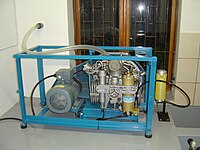
Photo from wikipedia
Abstract Functionalized solid amine-based temperature swing adsorption (TSA) processes have recently been proposed as a potential way to reduce the energy-penalty of post-combustion carbon capture processes. Thereby, multi-stage fluidized bed… Click to show full abstract
Abstract Functionalized solid amine-based temperature swing adsorption (TSA) processes have recently been proposed as a potential way to reduce the energy-penalty of post-combustion carbon capture processes. Thereby, multi-stage fluidized bed contactors with immersed heat exchanger surfaces and counter-current flow of solids and gas phase may solve the heat transfer challenge while maintaining the thermodynamic process requirements. Hence, the present work develops design requirements for TSA stages based on achievable heat transfer rates in bubbling fluidized beds. The considered particles are Geldart Type B. It is shown that the pressure drop of multi-stage fluidized bed TSA units for flue gas CO 2 capture is practically determined by the heat exchange requirement. Scalability, maintainability and durability of different heat exchanger geometries are considered. The net movement and mixing of particles within the bubbling bed stage must be maintained in spite of the immersed heat exchangers concerning possible dead zones in the area of the tube bundles. Comprehensive models are used to predict heat transfer coefficients for tubes immersed in fluidization. A heat transfer measurement test device for optimization of the heat exchanger geometry has been put into operation and heat exchange measurement results are compared to calculated heat transfer coefficients. It is shown that experimentally obtained heat transfer rates for single tubes are in good agreement with modeled values. A model proposed for Geldart A particles is used to estimate heat transfer rates for two particular tube bundles with a tube diameter of 25 mm and horizontal tube spacing of 2.2 and 2.8. It is shown that the calculated results represent heat transfer rates qualitatively and quantitatively for tube bundle heat exchangers immersed in Geldart Type B particle fluidized beds. Although this article has been motivated by heat exchange in TSA, it may be of interest for other applications concerned with heat transfer between bubbling fluidized beds and immersed heat exchanger surfaces.
Journal Title: Powder Technology
Year Published: 2017
Link to full text (if available)
Share on Social Media: Sign Up to like & get
recommendations!